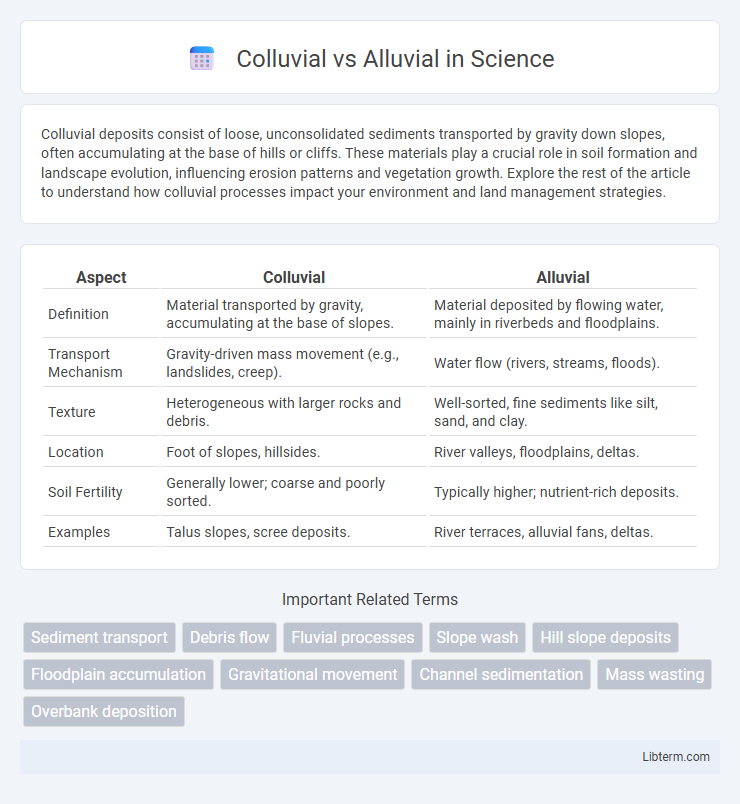Colluvial deposits consist of loose, unconsolidated sediments transported by gravity down slopes, often accumulating at the base of hills or cliffs. These materials play a crucial role in soil formation and landscape evolution, influencing erosion patterns and vegetation growth. Explore the rest of the article to understand how colluvial processes impact your environment and land management strategies.
Table of Comparison
| Aspect | Colluvial | Alluvial |
|---|---|---|
| Definition | Material transported by gravity, accumulating at the base of slopes. | Material deposited by flowing water, mainly in riverbeds and floodplains. |
| Transport Mechanism | Gravity-driven mass movement (e.g., landslides, creep). | Water flow (rivers, streams, floods). |
| Texture | Heterogeneous with larger rocks and debris. | Well-sorted, fine sediments like silt, sand, and clay. |
| Location | Foot of slopes, hillsides. | River valleys, floodplains, deltas. |
| Soil Fertility | Generally lower; coarse and poorly sorted. | Typically higher; nutrient-rich deposits. |
| Examples | Talus slopes, scree deposits. | River terraces, alluvial fans, deltas. |
Introduction to Colluvial and Alluvial Deposits
Colluvial deposits consist of loose, unconsolidated sediments accumulated at the base of slopes due to gravity-driven processes such as soil creep, landslides, and surface runoff. Alluvial deposits form from sediment transported and deposited by flowing water, typically found in riverbeds, floodplains, and deltas, characterized by sorted and stratified materials like sand, silt, and gravel. Understanding the distinction between colluvial and alluvial deposits is essential for geological mapping, soil analysis, and land-use planning.
Defining Colluvial Deposits
Colluvial deposits consist of loose, unconsolidated sediments that accumulate at the base of slopes due to gravity-driven processes such as soil creep, landslides, and rockfalls. These deposits are typically angular, heterogeneous, and poorly sorted, contrasting with alluvial deposits that form from water transportation and are well-sorted and rounded. Colluvial sediments play a critical role in landscape evolution and slope stability, often indicating recent or ongoing mass wasting events.
Understanding Alluvial Deposits
Alluvial deposits consist primarily of sediment transported and deposited by flowing water, characterized by well-sorted sand, silt, and gravel layers typically found in riverbeds, floodplains, and deltas. These deposits are crucial for understanding soil fertility, groundwater recharge, and natural aquifer formation because their porosity and permeability influence water movement and nutrient distribution. In contrast, colluvial deposits result from gravity-driven processes such as landslides and soil creep, often containing a mix of unsorted sediments on slopes with less stratification and water transport influence.
Key Differences Between Colluvial and Alluvial
Colluvial deposits form from gravity-driven processes like landslides and soil creep, accumulating at the base of slopes with poorly sorted, angular fragments. Alluvial deposits originate from water transport, primarily by rivers and streams, resulting in well-sorted, rounded sediments often found in floodplains and riverbeds. The key differences lie in the mode of transport, sorting, and sediment characteristics: colluvial deposits are typically coarse, unsorted, and deposited by mass wasting, while alluvial deposits are well-sorted and shaped by fluvial dynamics.
Formation Processes of Colluvial Materials
Colluvial materials form primarily through gravity-driven processes such as soil creep, landslides, and debris flows, resulting in the downslope accumulation of poorly sorted sediments. These deposits typically occur at the base of slopes where fragments of rock and soil detach and move downward without the involvement of water transport. Unlike alluvial materials transported and sorted by running water, colluvial deposits are characterized by irregular particle sizes and chaotic layering due to their mechanical displacement.
Formation Processes of Alluvial Materials
Alluvial materials form primarily through the action of flowing water, which transports and deposits sediments such as sand, silt, and clay in riverbeds, floodplains, and deltas. The continuous movement and sorting by currents result in well-layered, stratified deposits with varying grain sizes depending on flow velocity and sediment supply. In contrast, colluvial materials accumulate via gravity-driven processes like landslides and sheet wash, lacking the sorting and stratification characteristic of alluvial deposits.
Geographical Settings and Occurrence
Colluvial deposits accumulate at the base of slopes or hillsides, formed primarily by gravity-driven processes such as soil creep, landslides, and surface runoff, often in mountainous or hilly terrains. Alluvial deposits occur in floodplains, riverbeds, and deltas, created by the action of flowing water transporting and depositing sediments in flatter, low-lying geographical settings. The spatial distribution of colluvial deposits is typically irregular and localized, whereas alluvial deposits are widespread along active fluvial channels and valleys.
Soil and Sediment Characteristics
Colluvial soils are characterized by poorly sorted, coarse sediments deposited primarily through gravity-driven processes like landslides and sheet wash, resulting in heterogeneous texture and angular particles. Alluvial soils, formed by water action in rivers and streams, typically consist of well-sorted, fine to medium sediments with rounded particles, exhibiting higher fertility and better drainage due to consistent sediment layering. The distinct deposition mechanisms influence their soil structure, nutrient content, and suitability for agricultural or geological applications.
Environmental and Agricultural Implications
Colluvial soils, formed from gravity-driven sediment accumulation on slopes, typically exhibit poor drainage and higher erosion risks impacting vegetation stability and crop selection. Alluvial soils, developed from river-deposited sediments, possess rich nutrients and superior moisture retention, promoting fertile agricultural lands ideal for diverse crop cultivation. Environmental management in colluvial zones requires erosion control measures, while alluvial regions demand flood management to sustain soil health and agricultural productivity.
Summary: Choosing Between Colluvial and Alluvial Contexts
Colluvial soils form at the base of slopes through gravity-driven processes, offering rich mineral deposits but often with poorer drainage and higher erosion risks compared to alluvial soils. Alluvial soils, deposited by flowing water in riverbeds and floodplains, are typically more fertile and better suited for agriculture due to their fine texture and nutrient content. Selecting between colluvial and alluvial contexts depends on factors such as soil fertility, drainage capacity, erosion susceptibility, and the intended land use or ecological purpose.
Colluvial Infographic

 libterm.com
libterm.com